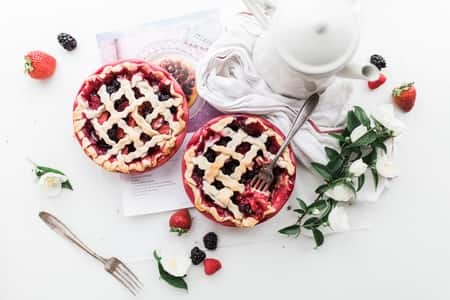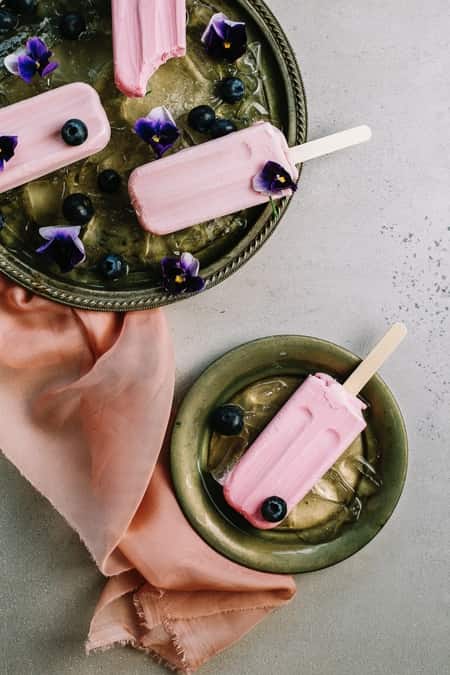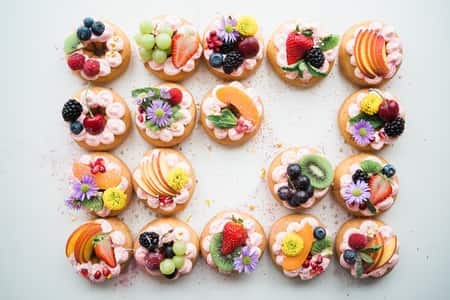We consume food with our eyes before it even reaches our mouth. That’s why edible orchids are a way to spice up any recipe.
Since the beginning of Chinese literature, orchids have found been famous for medicinal properties, too. Unfortunately, none of the orchids are tested in our modern-day labs for their medicinal value, tradition still holds orchids in high regard when it comes to food and health value.
Are orchids edible? All orchid flowers and leaves are edible. Roots have not found their way into recipes or medicine, but pseudobulbs and tubers have. Since the potting medium comes into contact with fertilizer and chemicals in the potting mix, it’s best to avoid consuming orchid roots.
Before You Start Cooking Edible Orchids – Read This
Day-lilies, lilacs, sunflowers and tulips are also edible and found their way into recipes quite often. When looking for orchids to serve, the most common sued ones for culinary purposes are Dendrobiums and Epidendrums.
As for the taste, most orchids have a light vegetable taste with a final touch of sweet-bitterness towards the end. Some have a blander taste, like that of lettuce, endive, or chicory.
You’ll have to experiment, since taste is hard to describe.
If you’re worried about preparing edible orchids and how long they’ll last before wilting, don’t be. A cut orchid will last up to ten days in your refrigerator, at around 36-40ºF. It will hold its freshness and shape long before your guests have left.
If you are worried about orchids being poisonous or toxic, they aren’t. What can be poisoning is the potting mix they’re sitting in. We’ve written 2 articles about the risks and concerns of potting mix, especially for pets, like cats and dogs. Both articles talk about different issues, since they are two different animals, so check those out.

You can buy cut edible orchids at bigger grocery stores, like Sam’s. If none are close to you, try California Specialty Farms at Amazon (Afiiliate Link) .
.
Ways to Serve Edible Orchids:
SALADS: There are many ways to add orchids into meals and serve them at the table. One of the most common ways is to serve a dip and place the orchid on top of the garnish. Another commonly served tip is to mix them up into the green salads, to add a touch of splash and color.
DRINKS: Serve an edible orchid in drinks, too. A common usage is in a cocktail. The splash of exotic color will make your guests smile. Another way is a traditional drink form Turkey, called Wild Orchid. This one is made with hot milk, nutmeg, and the tuber from a Salep orchid.
If you like tea, fill ice-cube trays up with water and add a small orchid flower to each cube. When ready to serve, place the ice-cubes in the pitcher.
Another fancy way to serve edible orchids is in a glass of water with slices of fresh apples, strawberries, blueberries, and a zest of lemon.
MAIN DISHES: In Singapore, a traditional dish prepared with stir-fired vegetables is made by adding orchids. Orchids enhance a zesty taste to the vegetables, and are the perfect addition for flavoring meat.

Prefer the soft-cane dendrobium orchids for this recipe.
Why keep the vegetables? You can go for the delicacy of just frying the flower. In Thailand, dendrobium orchids are dipped in flour and egg-batter then deep-fried, called Orchid Tempura (see the recipe below).
Not only in the stir-fry, but also add orchids to marinades, making the perfect salad dressing. They can de placed in oil, vinegar, and flavored jellies.
DESSERTS: Flowers made of frosting have been long used to decorate cakes, but you can crystalize orchids and add them to wedding cakes and desserts for special occasions.
The best way to end a meal is serving a piece of dark, luscious chocolate cake, white-colored vanilla ice-cream, and a red orchid to top it off. The visual of this dessert swoops your guests away.
Believe it or not, vanilla and ice-cream are also made with orchids, but we’ll talk about that below.

The Downside of Edible Orchids
One hazard: many people have allergies to pollen and specific food allergies as well. If you’re not sure about the orchid you’re using, then start with a small flower and gradually add more if no symptoms appear. Some species of orchids have higher concentrations of pollen than others.
People who have asthma might react to eating an orchid—it’s not a tested theory but reports have shown there “might be” a correlation.
Always asks guests beforehand if they have any food restrictions.
The Most Common Edible Orchid: Vanilla
One of the most common orchids widely used today is the vanilla bean orchid.
Not usually remembered as being an orchid, but vanilla is an orchid. The uses of terrestrial orchids have reduced to adding flavor to coffee (Albania), cigars (Cuba), and making ice-cream (Germany, Afghanistan, India and Greece.)Its not the flower that is consumed to make vanilla, but the seed pod. The Spanish “discovered” the vanilla orchid when encountering the Aztecs. In 1510, vanilla found it’s way back to Europe, where is was commercialized. Only in the 1800’s did vanilla spread through-out Europe.
Vanilla wasn’t only used for the flavor. The Aztecs used the seeds to alleviate nausea. Many chemotherapy patients also used vanilla to soothe the aftermath of treatment, improving their appetites. If you want to know how to cultivate the vanilla orchid, check out this article that I wrote. It’s a good place to start.
Medicinal Uses of Edible Orchids
Orchids have not only been used for food, as shown with the vanilla seeds. They have eased their way in (or way out – depending on how you look at the trend) to medicine and many cultures swear by the benefits of orchid consumption.
As mentioned before, there is no scientific grounding of the benefits of eating orchids, at least not in modern-day science. But tradition has long passed through generations that eating orchids does bring paybacks, and this data is seen as early as Confucius (551–479 BC).
Chinese culture speaks of orchids as related to “all things feminine, noble and elegant”.
The culture also has high regards of orchids as being related to a numerous family.
Japan shares this same tradition. When the Emperor’s wife, (funny that none of the articles mention her name) who couldn’t have children, smelled the fragrant Cymbidium Ensifolium, she was miraculously cured.
She birthed 13 children after this.
Not quite sure if the story is based on undocumented facts or just fairy-tales, but the story did cause repercussions in Japan, making the orchid one of the most sought out flower in the country. From peasants to noble samurais, everyone carried an orchid with them to bring prosperity and fertility.
The Greeks also related the orchid to fertility. The orchid received its name from Theophrastus (372–286 BC). The Greeks correlated the tubers on the orchids closely resembled testicles, which in Greek is orchis.
Many recipes would include the pseudobulbs and tubers in traditional cooking to provide extra “maleness” when conceiving children.
The Salep Orchid was used as a miracle drug. Once the word spread, many terrestrial orchids were introduced to traditional cures, mainly as aphrodisiacs, antiseptics, anti-pyretic (reduce fever) and to reduce gastrointestinal irrational.
Don’t Stop Learning!
If you want to be included in more information and get a 14-page fertilization guide, please sign up for my newsletter. I don’t spam, but send emails out bi-monthly with some curious topics of interest. If you want more information, click here to go to a specific page on this website where I explain it more in detail.

Also, if you are looking for an orchid journal to keep your notes specifically about orchid care, check out my 2 solutions for that on this page. If note-keeping isn’t your thing, then there is a free excel spreadsheet that you can download. Click here for more information on how to do that.
If you subscribe to my newsletter, I will send you a 14-page guide on the main tips of orchid fertilizer. It is downloadable and you can print it out on your computer. I designed the guide to double up as a coloring book, just to make it fun.
Since none of this is proven, lets move on to something that is, with reviews, comments, and many people talking about their proven and tested orchid recipes. For starters, I’ve chosen a simple one that is quite easy to make: Orchid Tempura, a traditional relish from Thailand.
How To Make Orchid Tempura
When selecting orchids for this recipe, or any recipe for that matter, don’t pick orchids off a market or a garden center and take them home. They may be filled with pesticides and fertilizers.
It’s best to order edible orchids online and use those, which are proper for human consumption. We’d like to say use your own, but that is extremely hard to do after the hard work put into cultivating the orchid to blossoming phase.
That would be like killing a pet. So…no. Just buy them online. 😊
Ingredients:
Dendrobium flowers
Broccoli, cut up into tiny florets, the same size as the flowers (small)
Carrots, also diced into small circles
You may add other vegetables here of your choice
1 cup flour
1 egg
Salt, to taste
Pepper, to taste
1 cup COLD carbonated water (sparkling)
Note: if your water is not cold, add ice cubes to the mix to really keep the temperature low
How to Prepare the Batter:
Mix the egg, flour, salt, pepper and carbonated water to form a liquid. If the mixture is room temperature, add ice cubes. The shock in the temperatures is what makes Orchid Tempura light and flaky. Don’t let the ice cubes melt, since this will through off the liquid proportion of the coating.
Heat the skillet to 375ºF (190ºC) and fill with frying oil.
Carefully place the chopped item in the batter. Cover each ingredient but don’t stir too hard, or the orchid will disintegrate. Make sure they are well-covered in the frying batter.
If you want to go the Thai style, use chop sticks to dip the orchids into the frying pan, only when hot. They shouldn’t take too long in the fryer. Flip them once, to fry all sides evenly. When they are light yellow in color, take them out and dry them on a paper towel.
And voila, you have made your first edible orchid recipe!
Happy cultivating, or better yet, happy eating!

